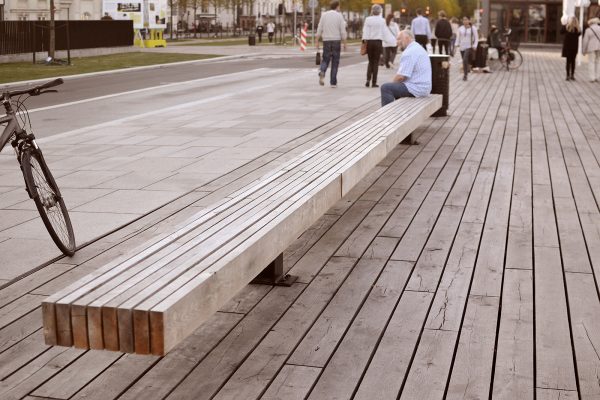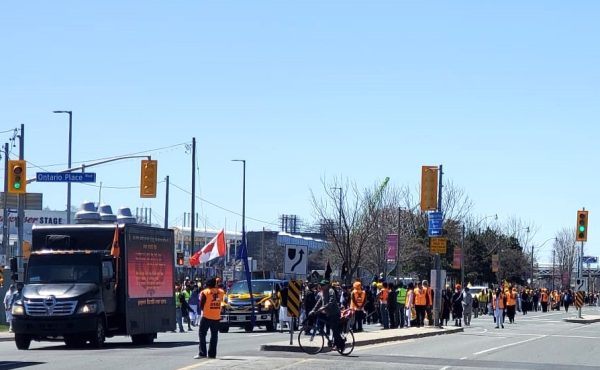It feels like the city is bursting at its seams. The glue that holds us together, including the public realm and city services such as transit and shelter care, are underfunded and in disrepair. Years of austerity politics paired with uneven development are deepening social, economic, and spatial divides. The lack of care for people struggling with homelessness, substance use, and mental health has led to needless suffering, increased fear, and a culture of pessimism and cynicism.
While parts of Toronto continue to see investment in the public realm, these spaces are meant to attract new people and investment — whether it be tourists on the waterfront or new residents in high-rise developments.
Conversely, everyday public spaces are ordinary and messy. They are an essential part of many people’s everyday lives, rhythms, and routines. From neighbourhood parks to local streets and laneways, these are sites for recreation, leisure, socializing and survival. These are the ordinary public spaces that provided respite for many during the darkest days of COVID19. They are also the spaces that hold so much potential for transforming the daily lives of Torontonians.
Toronto’s June 26th mayoral by-election is an opportunity to shift status quo politics and bring in a new vision of the city — one that focuses on improving the daily lives of Torontonians. Small investments in ordinary public spaces can do much to improve the quality of life of many urban residents. In the way that roads, office buildings, and factories form the economic infrastructure of the city, public space is part of the social infrastructure that connects us. For an increasingly divided city, shared space provides a shared reality where people can come together, engage with one another, and encounter difference.
A key component in any public space is people. Without people, a place is more like an empty container waiting to be filled. As the radical geographer Doreen Massey observed in 1994, place is a process, “constructed out of a particular constellation of social relations, meeting and weaving together at a particular locus.”
Since people and relationships (with each other, with the land, with the city) are essential components of place, the city must champion the creation of and maintenance of public spaces that meet the needs of local residents and visitors alike. This process starts with looking at the basic needs we all have as human beings — places to sit and rest, places to go to the washroom, places to escape the elements.
Small improvements, like increasing the number of benches in Toronto’s streets and parks, can make a massive difference especially for people who are under-represented in our public spaces. Accessible, comfortable seating is a necessity for folks who have mobility and stamina issues such as people with disabilities, people who are elderly, and people who are pregnant. The lack of a network of reliable, accessible seating throughout the city creates additional barriers that can prevent some groups of people from navigating the city and accessing the benefits of public space.
Paying attention to the location, amount, and position of seating is also something that can improve the quality and social life of public spaces. Positioning benches where there is something to look at, whether it’s a garden or the street, seems to be self-evident, yet the city positions a surprising number of benches in ways that don’t take account the preference of park users.
In addition, we can take care to situate benches in groups so people can gather. Even if you’re not a part of a group, there can be something comforting about being alone with others. As sociologist William H. Whyte pointed out in his observations of public space in 1980, “What attracts people most, it would appear, is other people.”
Finally, the lack of benches in Toronto’s parks and streets creates a sense of false scarcity. Benches don’t cost an exorbitant amount of money (City officials told Spacing that the outlay is $1,500 per bench, installed), so there’s no reason why we end up with only one or two in a new park rather than pathways lined with benches, seen in other cities like Montreal, New York or Mexico City.
The absence of benches and other public amenities like washrooms and water fountains is sometimes an oversight but is often deliberate. The lack of amenities that support human well-being in public space is what I call `ghost amenities.’ This manufactured scarcity is one the of strategies of defensive urbanism — a spatial management and design practice that uses the built environment to guide or restrict behaviour in urban space. It’s often applied to public spaces as a way to increase surveillance and security and to move along people deemed `undesirable,’ a.k.a. non-consumers and young people. Removing or not including amenities for fear of loitering, misuse, or vandalism makes the city more hostile to all.
The mayoral by-election presents a chance for all of us to vote for a new vision of the city — one that prioritizes people over profit. Improving the public realm, the glue that holds the city together, is a necessary task that the incoming mayor must address. Rather than continuing to invest in new, spectacular public spaces, we must shift our attention and restore our everyday parks and streets, where small improvements provide the largest impacts for the most people.
These ordinary and often neglected public spaces are essential parts of our everyday lives and they deserve some extra love and care. Toronto’s incoming mayor must pay attention to these spaces that bring us together because together we can build a city we truly deserve.
photo by Matthew Blackett
Cara Chellew is a PhD student in Urban Planning, Policy, and Design at McGill University and the founder of DefensiveTO, a multi-media project which documents defensive/hostile urbanism in Toronto and beyond. Follow her on twitter at @carachellew.





One comment
People need backs on benches. A bench without a back is just a place to tie your shoe.